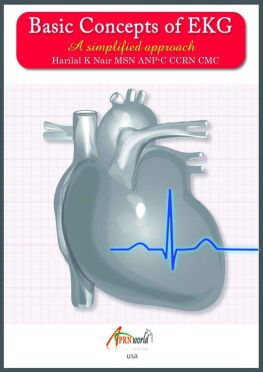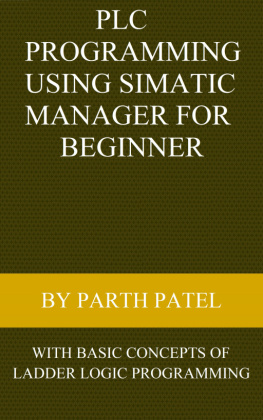Basic Concepts of EKG
A Simplified approach
Harilal K Nair MSN ANP CCRN-CMC

APRN World
USA
Copyright ARPN World
Publishers statement
All the content, illustrations and methods used in this book are copyrighted to the publisher ARPN World and the author of this book. Any part, including illustrations or excerpts of this book should not be used other than for non commercial and individual educational purposes in the form of copy, print or any other electronic or other forms of communication media without written permission from the author and the publisher.
Disclaimer
This book is intended for beginners and professionals who are trying to develop better understanding of basic concept of EKG and its analysis. Therefore, this book is in no way a substitution to clinical judgment as well as established medical guidelines for actual patient care in the field. Since the modern medicine is a dynamic arena with constant addition of newer knowledge from clinical research, the author and the reviewers made genuine efforts to include most accurate and up to date information in all parts of this book. However, because of the ever-changing nature of technology and science, the author or publisher is not responsible for any inaccuracies of information especially related to drugs and devises described in this book. Since this book is not meant as a resource for active patient care, the individual learners are expected to take best efforts to identify most updated information in this regard from other available sources.
ISBN-13: 978-0-9885701-0-8
Library of congress catalog number- in process
Publisher Information
www.aprnworld.com
For print version of this book,
Please search in Amazon (R) , www.aprnworld.com and other major publishers.
Preface
Basic concepts of EKG- A simplified approach is an attempt to make the complex nature of EKG analysis to fairly simple and logical endeavor. A rationalized approach with simplified analogy method is used throughout this book. I believe in the simple to complex and concrete to abstract nature of student learning and therefore, a substantial effort has been made to make each and every concepts of EKG in to simple building blocks for a complex learning process. With conscious awareness, I havent gone much in to the complexities of electrophysiology as they may be bit advanced for targeted learners without more practical experience with EKG analysis. I would like my readers to consider this book as one of the basic textbooks they use to build a strong foundation for their advanced learning.
I would like to reiterate the basic concept for effective use of this book that every part is important in building a stable foundation for further advancement in EKG analysis. Being a constant leaner by myself, I dont appreciate books with complex concepts without sufficient explanations. Therefore, being very critical to my work, I did my best effort to remove any clutter and made it simple and up to the point with adequate rational explanations of events in all possible ways.
In order to facilitate multisensory learning of core ideas, appropriate drawings and highlights of important points are included throughout this book. I hope this will enable the students to easily skim through the chapters after their initial thorough reading. All of the important points are color coded and highlighted so that they are more visible than simple detailed mono color paragraphs of the traditional books.
I understand the fact that there are errors in every work no matter how many reviewers sweep through it. Therefore, I would like my readers to send us feedback so that we can improve ourselves for our future editions. I highly appreciate your comments and looking forward for every opportunity to improve and help someone to understand the complexities of modern medicine.
I would like to thank my mentors and support team for constant encouragement, support and confidence that they impart on me to make this book a reality in considerably short period of time. Without them and above all, the help of god almighty, I wouldnt be able to make this project a success.
Sincerely
Harilal K Nair MSN ANP-C CCRN- CMC
Consultants and Reviewers
Dr. Ashis Mukherjee MD
Medical Director,
Inland Empire Heart and
Vascular Institute (IEHVI)
2101 N waterman Ave
San Bernardino CA 92404
Dr. Prabhdeep Sethi MD, MPH
Interventional Cardiology
IEHVI, 2101 N waterman Ave SBD 92404
Susan Elwell RN MSN
Clinical Educator, Cardiac Services
St Bernadine Medical Center
2101 N waterman Ave SBD 92404
Francis McDowell RN PA-C
Cardiovascular Quality Coordinator
IEHVI, 2101 N Waterman Ave SBD 92404
John Staples RN
Cardiac catheterization Laboratory
IEHVI, St Bernadine Medical Center
2101 N waterman Ave SBD 92404
Helen Bigelow RN CCRN
Cardiac Services
St Bernadine Medical Center
2101 N Waterman Ave SBD 92404
Arlene DaJose RN BSN CCRN
Cardiac catheterization Laboratory
IEHVI, St Bernadine Medical Center
2101 N waterman Ave SBD 92404
Design and Art

Sincere thanks to
My Family
My mentors
and
Above all
The God Almighty
to make this book a reality.
Table of Contents
Part I
Basic Cardiac Physiology
Chapter 1
Fundamentals of Cardiac Function

T heheart is a delicate muscular structure lies in the mediastinum and is protected by the rib cage. It is usually situated left of the midline and above the diaphragm. The part of the chest wall overlying mediastinum is called precordium. The apex of the heart is the conical part lies at the bottom and is more towards anterior wall of the chest. Base of the heart is the wider surface along with greater vessels situated on the top. Anatomical variations in position of the heart and greater vessels can be found in cases like dextrocardia, where the apex of the heart is rotated towards right side.
Circulatory System
The human heart has four pumping chambers known as right atrium , right ventricle , left atrium and left ventricle . Along with pumping blood to the systemic and pulmonary circulations, these chambers have unique role in maintaining various hemodynamic parameters. Therefore, assessment of blood volume, pressure, temperature etc. at various parts of the circulatory system can help in identifying pathophysiologic changes of the heart and other associated structures
 Fig 1.1 Anatomical location of the heart
Fig 1.1 Anatomical location of the heart
The heart is a combination of two distinct pumping systems: right pump and left pump. Right atria and ventricle act as the pump for pulmonary circulation whereas; left atria and ventricle constitute the one for systemic circulation . These two systems are seamlessly connected through the lungs. Both functional units have their own reservoirs (right and left atrium), individual pumping chambers (right and left ventricle) and distinct valve structures that ensure unidirectional flow of blood in the system.
















 Fig 1.1 Anatomical location of the heart
Fig 1.1 Anatomical location of the heart